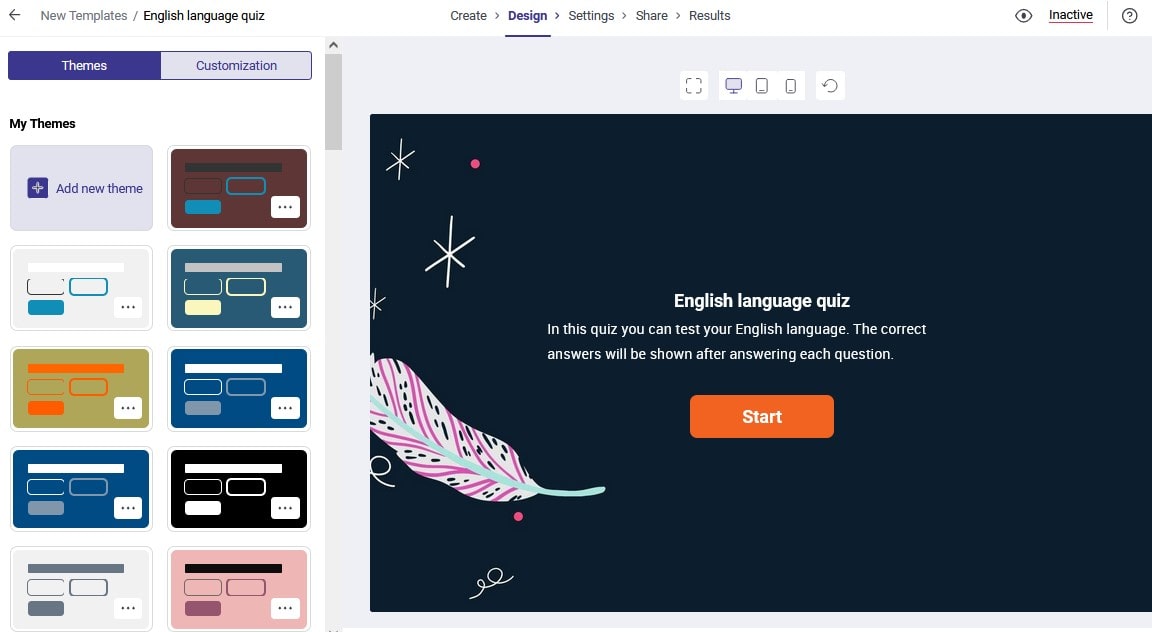A Guide to choosing the type of online survey questions

The golden method of efficient managers in the past and present has always been to look at the organization from the customers’ point of view. While managers in other organizations try to provide better services with high quality, efficient managers investigate customer feedback.
For many years, these two methods of «investigating customer feedback» and «providing better services» were equal from the public’s point of view. But the truth is that they are «different as day and night». One organization may provide the best services and products while customers are looking for other services and products. This simple yet accurate point, i.e. the market need, determines the difference between «successful organizations» and «the most successful organizations».
In the following, we will tell you how successful managers look at their organizations from the perspective of their audience using online survey. We also investigate the method of choosing the type of online survey questions and achieving its required quality.
The importance of the quality of online survey questions
Needless to say that the simplest and least expensive method for determining the organization’s future plans and goals is online survey. But this does not mean that any online survey can have such an ability. Asking wrong questions is a big risk to the system because wrong planning can start from here.
Understanding the common mistakes that ruin the survey helps improve the process of designing online survey questions.
On the other hand, good questions have a huge potential to persuade the audience. These questions do not distract the attention of the respondents but rather lead them directly to the goal of the survey designer.
Simply, good questions speak the same language as the audience. In this way, the audience will be interested in answering them and expresses their thoughts to you out loud.
In the end, you will have a complete list of customer needs and their purchase motivations, a list that determines the procedure to achieve your goal, which is customer satisfaction.
Key points to consider before asking online survey questions
It is generally believed that questions should be designed immediately after deciding to design a survey. But it is more important to consider the following points before designing online survey questions:
1. Planning and formulating goals
Planning and understanding the goals of designing a survey are the first step. By doing this, you will not have any deviation from your goals, and the questions will be consistent with the «goal of designing the survey». After that, formulate your ideas and goals so that you don’t deviate from them at every level of the process of developing online survey questions.
2. Understanding the answers
Usually, the first thing to do is writing down all the questions that come to your mind. But we suggest that you write down all the answers you need. This way, questions that have no reason to be asked are automatically discarded. You will also have a shorter survey that will attract the attention of a larger audience.
Tips for writing an online survey according to Harvard Business
According to Harvard Business, when people answer online survey questions, they are actually thinking out loud. So don’t miss the opportunity and take this into consideration. In this context, Harvard Business has provided special advice, some of which are briefly mentioned here:
- Briefly and simply explain to the respondent how to fill out the survey.
- Design a short survey, because respondents are less willing to respond to a long survey.
- Pay attention to the correct order of the questions, because the correct order drives the respondents to continue responding.
- Before sending the survey to the public, share it with your friends to know if there is any problem.
- Use a welcome page to establish a good relationship with your audience.
- Start with general and easy questions.
- Think about questions that respondents would be interested in answering.
- Avoid using specialized terms and words.
- Don’t confuse the respondents with ambiguous and incomprehensible words and sentences.
- Avoid asking multiple things in one question.
- In multiple-choice questions, try to include all the items. Otherwise, use the «Others» option.
In general, Harvard Business believes that good questions convey the intended concept of the survey without including other concepts so that the respondents derive the same main concept from it.
Criteria of good and bad questions in writing an online survey
The most important issue is having an insight into the organization and its services and products. For example, who are the people forming your target market? What are the obstacles that prevent people from buying from you? This issue shows you which questions are suitable for your survey. In this paragraph, we will mention some ideal criteria for online survey questions:
- Ask simple, direct and uncomplicated questions. In this case, the respondents will easily understand the questions and answer them. For example, in the question:
- Don’t you like using Google?
It is very easier to ask:
- Do you like using Google?
- Ask your question precisely to get an accurate answer. For example, instead of asking: What do you think of our services? Write: In your opinion, what should our organization do to improve our services?
- Do not ask more than one thing in one question.
- Avoid bias in the question. Respondents are not supposed to give your favorite answer. For example, instead of asking: How satisfied are you with our services? You should ask: What do you think of our services?
- Speak the language of the audience.
- In questions such as multiple choice, make sure of including all the answers in the question options. For example, the question: In what age group are you?
- 0 to 30; b. 30 to 60; c. 60 and above
The option for 30-years-old and 60-years-old people is not specified precisely in this question.
- Avoid questions such as asking about salary, which people may not be willing to answer. If you have to ask such questions, be sure to use the «I prefer not to answer» option.
- Avoid questions with repetitive concept. With a group of repeated questions, the audience would leave the survey.
- The best surveys are short ones that only take a few minutes to complete. Studies show that if the survey takes more than seven or eight minutes to complete, the number of respondents decreases by 20%.
Types of online survey questions

Each question type, whether opinion scale, rating, multiple-choice, ranking or text, falls into two categories of open-ended and close-ended questions. So when you design your survey, you must first decide whether the questions are open-ended or close-ended. A combination of both types can be used in one question. For example, by adding the “others” option to a multiple-choice question or a dropdown question, you give the respondent a choice if there is another option that the survey designer has left out.
On Porsline, with the help of “Question Group” you can create a unique division of the types of online form and survey questions and use a combination of these types of questions in each group. When you think about the types of questions in online survey, you should also think about formulating the questions accurately and using the principles of question design as well.
Therefore, when choosing between open-ended, close-ended or semi-close-ended questions, first ask yourself: Does this question provide me with the data I need to collect and analyze?
Porsline’s sample surveys and forms are good resources to use, but you can easily design your own survey from scratch if you want.
1. Open-ended questions
An open-ended question means that the respondent has an opportunity to clarify and express his own point of view and reasons. Sometimes, these details are very important to the survey designer. These questions start with phrases like “Why…”, “Please explain…” or “How…”. The analysis of these types of responses is qualitative and usually requires the supervision of the survey designer.
Open-ended questions can be a good method, especially if you still do not have a clear view of your customers. Open-ended questions help you identify customers’ needs that you didn’t know or you might not have considered before. If you use a set of short open-ended answers, you will limit the number of respondents and you will be able to acquire short basic insights from them.
Of course, open-ended questions also have disadvantages. The first of which is that people usually don’t like to give descriptive answers, especially if the number of such questions is more than one. On the other hand, it takes 5 times longer to analyze the answers to these questions than close-ended questions. However, the advantages of this type of online survey questions push you to use it sometimes.
- Text question
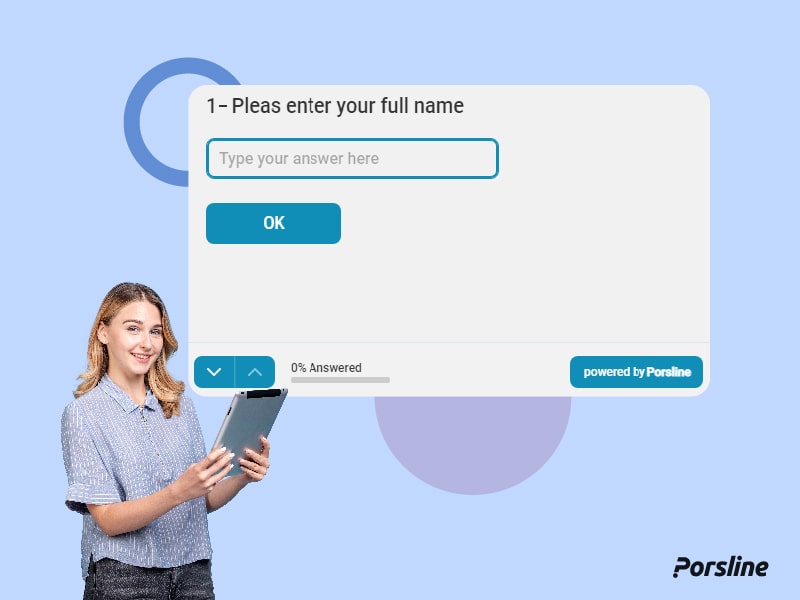
Text questions are the same as open-ended questions that can be used in different formats, including simple text answers, numerical answers and link/website/email-address answers. This type of online survey questions creates qualitative data. Therefore, they cannot be analyzed in the usual methods of descriptive statistics.
In this type of questions, you can choose the types of answers according to your needs. The great importance of these questions lies in the answers that the respondents give according of their own choice and within the scope of your definitions. For example, you may get many points of view by asking this question at the end of the survey: “What question do you think is missing in this survey?”
2. Close-ended questions
A closed question means that the respondent chooses from a list or predefined options and cannot explain his/her answer further. The most common close-ended questions are multiple-choice, rating, opinion scale, and ranking questions.
It is better to ask such questions, especially at the beginning of the survey, to encourage the audience to continue answering the survey. In fact, this method follows one of the marketing techniques called “foot-in-the-door technique”. According to this technique, if you can attract your audience to the entry door, you can also attract him/her to continue.
Quantitative analysis of this set of online survey questions is its most important advantage. You can present the organized data in the form of tables and charts while being able to analyze it quickly and easily. This advantage is helpful for statistics such as popularity surveys that are conducted continuously.
- Opinion scale questions
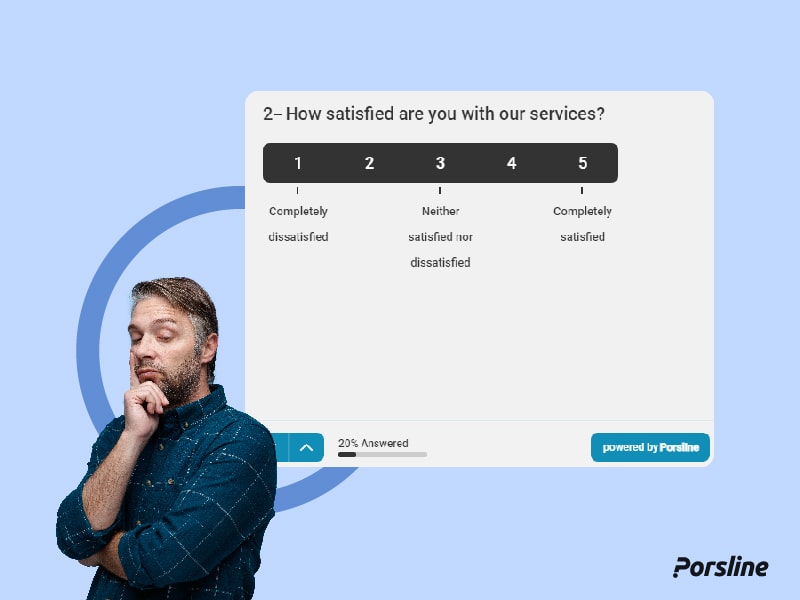
The opinion scale (Likert scale) and rating question is another type of close-ended questions that collect the respondents’ feedback and allow him/her to rate, give score and express his/her opinion. First, you must decide whether the metric or item to be measured is bipolar or unipolar; because the Likert scale examines bipolar indicators. For example, if the indicator spans from “strongly disagree” to “strongly agree” or from “completely dissatisfied” to “completely satisfied” or generally spans from negative to positive values (bipolar), so use the opinion scale question type, and here a neutral label such as “I have no opinion” should be added in the middle of the range when necessary.
The results of Likert scale questions can be analyzed based on “answers frequency”. In this way, the frequency percentage is displayed as a chart. For example, the percentage of agreed respondents, the percentage of the respondents who have no opinion, and the percentage of disagreed respondents can be specified. You can access Likert scale analysis and convert the Likert scale to a percentage in the Results section of your Porsline user panel.
The correct method in these cases is the opinion scale question, because it shows the results numerically. On the other hand, only three labels are shown in opinion questions, and the survey designer tends to make the question more concrete for the respondent. So the result is choosing multiple-choice questions. If you used opinion questions, in addition to extracting numerical results in an Excel file, it would be easier for you to use the data for other purposes. Furthermore, in the “Charts and Analysis” section, you will obtain indicators such as average, mode, and standard deviation.
- Rating question

If the indicator spans from zero to positive values and you want to collect data in this way, use the rating question type. Don’t forget that the respondent should easily interpret your scale to provide you with good data.
How likely are you to recommend us to a friend or colleague on a scale of 0 to 10?
How would you rate our customer service on a scale of 1 to 5?
- Ranking questions
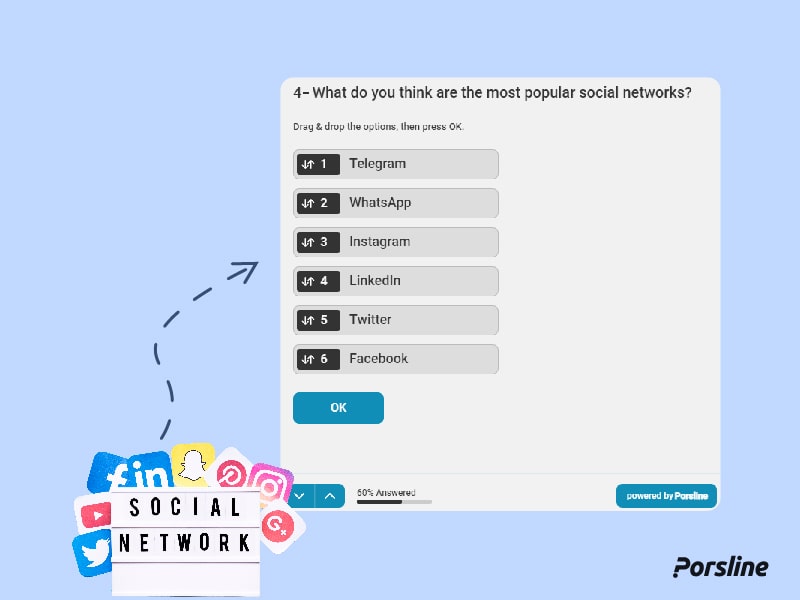
Ranking question is the question type that helps you determine audience preferences. As a general rule, use the ranking question type when you want to force the respondent to choose from several options and when the order of these options is important to you. For example, use it if you want to know the order of adding features to a product from the point of view of customers, or which dimensions of employee satisfaction are more important and which are less important to the employees.
In this type of online survey questions, you can explain to the respondent his/her ability to prioritize options with a brief explanation. Moreover, define logical relations and points by adding logic and calculations. Thus, you will have statistics and various tables and charts.
Of course, your audience may not understand the concept of ranking questions well. Then, you will definitely not get the result you want. Therefore, your explanation of how to fill out this type of online survey questions should be comprehensive and expressive.
- Multiple choice questions
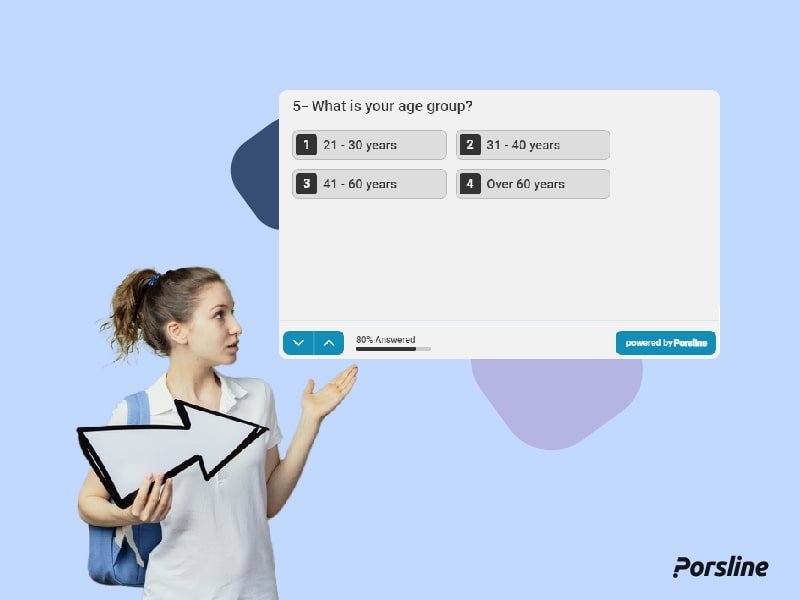
A multiple-choice question or dropdown list is the most common question in online forms and surveys that displays several options for the respondent to choose from. Depending on the nature of the question, answering this type of question can be accompanied by choosing one option or several options at the same time.
Depending on the number of options, you can choose the following types:
- Normal multiple-choice question;
- Dropdown question; It is chosen when the number of responses is higher than usual. For example, when the questions ask about the cities of a country;
- Picture choice question with a label for each picture. This type of multiple-choice questions creates an additional visual appeal;
- Yes/no questions that can be answered quickly and with the minimal mental involvement of the respondent. However, this type of online survey questions must be combined with other types of questions to finally collect useful information.
This type of question can be analyzed and interpreted quickly, but it should not be mistakenly used instead of the opinion scale (Likert scale) question. The options in the multiple-choice question are discrete, while they are continuous in the opinion scale question. If in some cases you prefer to use a multiple-choice question instead of opinion scale question, you should pay attention while analyzing the data to what mentioned above and extract the data appropriately.
Conclusion
Finally, to create a smart responding experience, you can show to each respondent only the questions related to him/her. In such cases, you should add logic to the survey questions and create logical relationships so that the survey will intelligently display the next questions based on each answer. In other words, make the survey skip the questions that are not related to the respondent.
Enriching online survey questions with photos or using appropriate colors in the survey is very effective in increasing the response rate.
Test your survey at first. If the engagement is low or if you have bad feedback, you should modify your survey and correct the mistakes.


